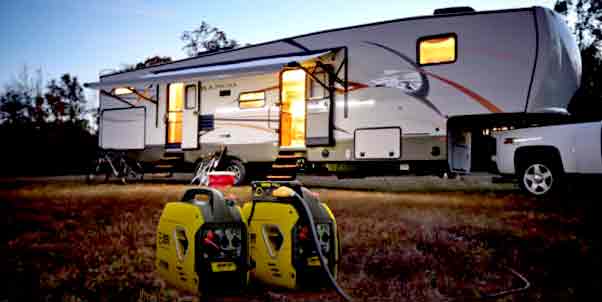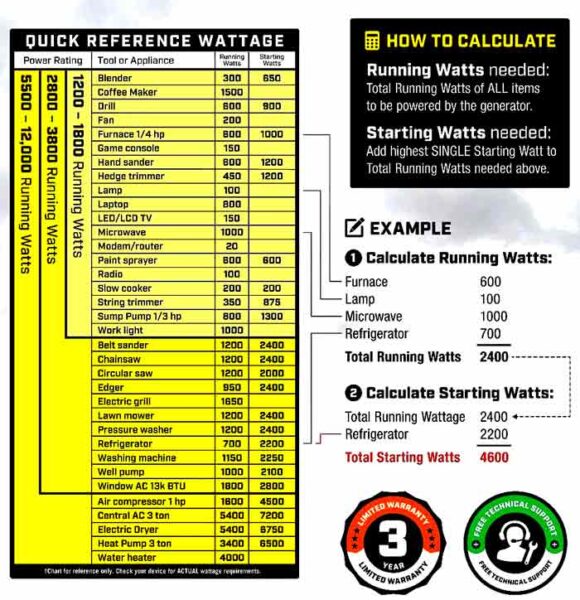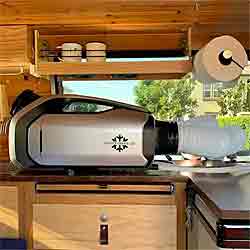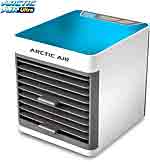Running RV Appliances, Like Air-Conditioners, Off-Grid
Being off-grid is a lifestyle choice that entails living with what the land provides you. That’s rarely enough power to run an air-conditioner (see video at the bottom of the page.) When we camp off-grid in our RV, our batteries provide just enough power to run the thermostat on the propane refrigerator, a few lights, and the furnace for the cold Colorado nights.
Technology continues to improve but you’ll still need a serious battery bank and powerful inverter to supply enough power for an energy guzzler like an air conditioner.
Generating Your Own Power Running RV Appliances Off-Grid
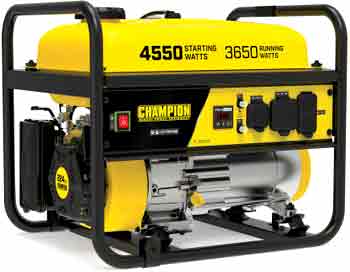 Generating your own power is doable. The simple solution is to fire up a noisy, non-ecofriendly, gas generator that’s powerful enough to supply your electrical needs.
Generating your own power is doable. The simple solution is to fire up a noisy, non-ecofriendly, gas generator that’s powerful enough to supply your electrical needs.
The CHAMPION POWER EQUIPMENT 3650-Watt RV Ready Portable Generator is the perfect combination of versatility and convenience. A powerful companion for your next camping trip or weekend project, this generator can also provide plenty of backup power for your essentials during an outage. For your RV, you’ll enjoy enough power to start and run a 15,000 BTU RV air-conditioner.
The reliable 224 cc single-cylinder OHV Champion engine produces 4550 starting watts and 3650 running watts, and will run for up to 14-hours at 50% load when the 4.7 Gal. tank of gasoline is full. You’ll have a noise level of 68 dBA from 23 ft., which is about as loud as a vacuum cleaner.
It comes with an electric start, a duel fuel option of gasoline or propane, a carbon monoxide auto shut-off, and RV ready.
The Volt Guard built-in surge protector prevents overloads and keeps your equipment safe from spikes in voltage. Currently $676.00 at The Home Depot.
Here’s a reference guide from Champion that gives you an idea of the wattage for different appliances in your RV or tiny house:
Visit this page to see other off-grid energy sources.
There are other, quieter, less expensive generators available if you want to just watch TV and run WiFi devices. See generators on this page.
RV electrical systems
RV electrical systems usually have a power center that holds the circuit breakers for the 110-220 volt AC outlets and equipment and the 12 volt DC distribution panel. Your RV will run the 12 volt equipment off one or more lead/acid car batteries. If your batteries have gone bad in the past, hopefully you have upgraded to deep-cycle marine batteries.
What most RV power centers don’t do is supply 110 volt AC to the outlets in the rig unless you are plugged into shore power or running a generator.
To get 110 volts AC from a 12 volt DC battery you need an Inverter.
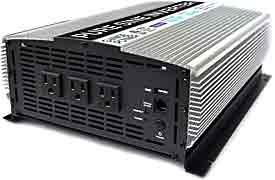 What is an inverter? They are electronic devices that can turn DC (Direct Current) to AC (Alternating Current). They are also responsible for controlling speed and torque for electric motors.
What is an inverter? They are electronic devices that can turn DC (Direct Current) to AC (Alternating Current). They are also responsible for controlling speed and torque for electric motors.
The inverter shown here can create very clean power for running TVs and other sensitive electronics. Technically it’s capable of supplying enough power for an air-conditioner too, but it would get very hot very fast. The load would drain a car battery to the damage point in three to six minutes.
An inverter powerful enough to run an air-conditioner for any length of time would be one typically found in a whole house solar system and cost about $1,300.00. Then you’d need an extensive bank of batteries and a lot of solar panels to back it up.
An inverter will draw battery power even with nothing plugged into it. You need to turn it off when not using it. It’s best to get an inverter that disconnects from the battery automatically when charge gets too low to avoid damaging the battery.
Solar systems frequently use 24v or 48volt systems. The inverter would need to operate with that voltage. The inverter is just part of the solar “system.” Go to our page on solar power for more information.
Running RV appliances off-grid: It’s all about the batteries
Whether you are producing power from a gas generator, wind generator, or solar panels, the batteries act as a voltage regulator allowing you to run your appliances without damaging them from fluctuating voltages.
Batteries store power too. Solar panels will produce less power on a cloudy day than a very sunny day. On cloudy days you’d use the solar produced and maybe some energy from the batteries to keep a nice smooth 118 volts, 60 Hz. supplied to your appliances thru the inverter. At night the power will mostly come from the batteries unless you are running your generator.
From the table above you see the current draw of the most used appliances. The appliances are usually rated by watts. Batteries are rated in amp/hours (a/h) so a little math is involved. From the table above you can see what the most popular RV appliances draw.
Here’s an example from Adventurous Way Blog: “A 6qt Instant Pot uses about 1,000W (or 1kW) when running in Sauté mode – the standard 50lb battery would be able to power the Instant Pot for less than half an hour before damaging the battery!”
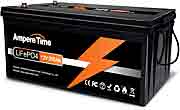
Lithium-ion batteries are expensive but last for many more charge cycles and maintain their full charge capability for a longer period of time than most other types of batteries.
This Ampere Time, 200 Amp Hour, Lithium Iron Phosphate, Deep Cycle Battery is a great value. This battery provides 2000~5000 cycles (10 times longer) & a 10-year lifetime compared to 300~500 cycles and a 3-year lifetime in lead acid battery. It weighs only 46 lbs. which is about a third of lead acid. They produce their optimal power over 90% of their charge cycle as opposed to lead acid batteries which are about 50%. $719.99. Click on image to learn more.
Three or four of these 12 volt, 200 a/h (amp/hour) batteries wired in parallel would make for a powerful battery bank.
Portable Power Station
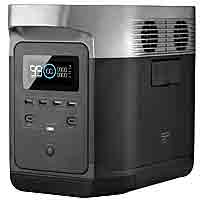
Portable Power Stations are sometimes called power “generators” because they were designed to be used while camping for the weekend instead of running a generator. To be clear, they do not generate power. But they function like running a generator without the noise, fumes, or gasoline mess.
Shown here is the Ecoflow Delta. It’s a portable power station. This is basically a huge capacity battery with an inverter built in. It can be charged at home by just plugging it in so it also has a battery charger built in. This will charge it to full capacity in under an hour.
The battery is a 1300Wh capacity, 100 Cell Lithium Ion Battery Bank. To compare to a car battery measured in amp hours it’s 105 a/h.
The M.S.R.P is $1,399.00* but currently on sale for just $899.00* on the Eco Flow website.
The Eco-Flow DeltaMax will run your essentials with 2400W AC output. Power up your AC, heaters, and other high-wattage devices using 3400W X-Boost technology. *X-Boost powers a 3400W device, but the rated output remains at 2400W to avoid overloading.
The Delta-Pro features additional battery capacity that can expand the storage capacity to whopping 25 kilowatt hours. Does get pricey, but it’s comparatively economical as far as battery storage systems are concerned.
It can also be charge with solar panels. The solar panels offered by EcoFlow basically trickle charge the battery pack to extend their charge.
Learn more about solar power on this page of Tiny Life Consulting.
Running a CPAP Machine Off a Portable Power Center
Just a quick detour because RVers ask about it all the time: Yes, you can run your CPAP machine from a portable power center.
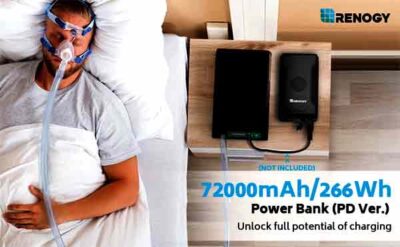 The high-performing DC 12V/5A (150W max.) cigarette lighter port is ready to boost most CPAP machines on the market with a CPAP adapter (PURCHASED SEPARATELY), including Philips Dreamstation, Resmed Airsense/Aircurve 10, and Resmed S9. Turn OFF the heater & the humidifier for extended runtime.
The high-performing DC 12V/5A (150W max.) cigarette lighter port is ready to boost most CPAP machines on the market with a CPAP adapter (PURCHASED SEPARATELY), including Philips Dreamstation, Resmed Airsense/Aircurve 10, and Resmed S9. Turn OFF the heater & the humidifier for extended runtime.
Packed with a enormous capacity of 72000mAh/266Wh as well as battery management system, this portable charger can pump out enough power to run multiple devices simultaneously.
Note: The TSA will not let you take this on a plane. Click on image to see details. $159.99.
Can You Run An Air-Conditioner Strictly Off Solar Panels?
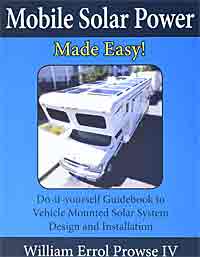
Add a solar system to your RV, Van, Trailer, Car or Boat-Step-by-step instructions that anyone can follow.
Running RV appliances off-grid is one thing. Running the power guzzling air-conditioner is another.
There was one company that touted their air-conditioner could run just off solar panels. I show it here on my website. But checking just now, I see that it is no longer available. It was the only one I ever saw that made this claim. It turns out this company was just selling standard grid-tied air-conditioner systems but sizing it smaller so it was within the electrical generating capacity of the solar cells. The two five-star reviews look suspicious.
The number of solar panels necessary to generate sufficient power to run a standard air-conditioner would be costly. You would also need a sufficient battery bank and an inverter to keep the power steady and not damage the motors in the device.
Renogy recommends eight of their best batteries with sixteen solar panels to run two RV air-conditioners for eight hours. A Soft Start Kit is also recommended.
Consider a Zero Breeze Battery Powered Portable Air Conditioner Mark3 as an Alternative.
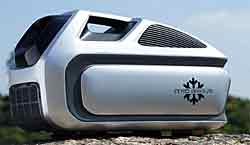
The Cordless & Battery Powered AC Zero Breeze Mark III is an actual mini air-conditioner. Available in the Spring of 2024 it will retail for $1,099.00 ($1,599.00 with battery). The ZeroBreeze Mark III produces 5280 BTU which is enough to cool a small RV, a room (like a bedroom) in a larger RV, or a tent. It runs off the 24 volt battery pack shown on the bottom of the unit for 2-7 hours. It even has a heat mode if needed. You can buy an additional battery pack that snaps on underneath for extended time.
Zero Breeze Portable Air Conditioner uses a high-efficiency miniature inverter air conditioner compressor and compact high-efficiency fan system. It draws 10 amps at 24 volts.
It takes just 2.5 hours to fully charge the Lithium-Nickel Manganese Cobalt (NMC) battery when plugged into a wall outlet and there is a cigarette lighter adapter to charge while driving or from a 12 to 75 volt solar system. You can run it directly from a standard AC outlet without the battery too. It uses only 240 w/hrs. at 24 volt. Weighing in at just 19.8 pounds, don’t expect it to cool down your 30′ long RV.
There is a nifty install kit included for RVs and tiny homes that adds ducting for intake and exhaust air. It draws air from the outside to cool the condenser of the a/c system then exhausts the same air back outside. The inside air is recirculated through the front evaporator side.
As any air conditioner it dehumidifies the air. There is a drain hose but it can contain the moisture then pump it out later to be used for other purposes like drinking or washing.
See more information about the ZeroBreeze Portable Air Conditioner as well as the EcoFlow Wave at this page of the Tiny Life Consulting website: Keeping Your RV Cool This Summer
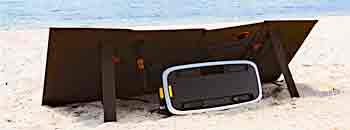
Charge the battery while driving thru the 12 volt plug adapter in your vehicle or via these solar panels.
Cooling Devices I Don’t Recommend
There are a host of evaporation or”swamp” coolers available at very low prices. The Arctic Air Ultra shown here is just $39.99. Hydro-chill technology pulls in hot air through an evaporative air cooling filter and turns it into cool, refreshing air. However, it only really works in low humidity areas and releases a lot of moisture into the air. It uses minimal electric power.
It might work great in my home state of Colorado where it can be drier than the Mojave Desert, but if you already have moisture problems in your RV this would only compound that issue while not working very well.
Our conclusion: Running RV appliances off-grid is very doable
With LiFePO4 Lithium Ion batteries it is possible to have an off-grid system large enough to run household appliance like an air conditioner.
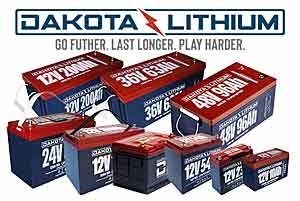
Dakota Lithium Batteries
Dakota Lithium batteries, shown here, will get the job done. They will assemble a package using Victron controllers that’s perfect for your application.
Their batteries can operate down to -20° F with over 2000 cycles. They’re guaranteed for an unprecedented 11 years. Click on image to see more.
Air Conditioning on off grid system video
Here is a YouTube® video of a guy showing the details of his $14K solar power setup that does indeed have enough juice to power a very efficient air-conditioner for his tiny home. His battery pack came from an electric car produced by Tesla.
The smart folks at RV Solar Connections specialize in off-grid solar systems.
Using Victron Energy, Lithionics Batteries, and Rich Solar products they’ll design the perfect system for you.
They have dozens of custom wiring diagrams you can download. Demystify your mobile electrical system with a customized RV solar wiring diagram. These diagrams include every component, wire and fuse to clearly show how the pieces of the puzzle come together.
Here’s a very informative blog post about powering an RV air conditioner with solar.
This Large Solar Power Kit Will Run Everything You Have
Including a well pump.
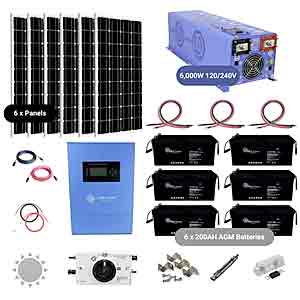
Looking for a solar kit that doesn’t cost an arm and a leg just to get installed? Tired of getting outrageous quotes from solar installation companies? Look no further. Our complete off-grid solar kit OGK-Plus comes with all of the parts and pieces needed to get up and running with clean, quiet, off-grid solar power.
With a 6,000 watt split phase (120/240V) inverter included, this kit is powerful enough to run lights, fridge, workshop, TV, well-pump and more! Easily expandable, you can add more batteries and more solar panels in the future!
Most off-grid kits on the market today only include a 120V inverter which is NOT able to handle things like a 240V well-pump or air conditioner for example… By going with a kit like this, that includes both 120V and 240V output, you’ll be in a much better position when it comes to long-term versatility and reliability.
 Running RV appliances off grid using solar power
Running RV appliances off grid using solar power
Shop Solar Power Kits website has many size kits so you can get just a starter kit that can be added to easily or buy a major system that will supply all of the power you could ever need.
Buying a kit means you’ll be getting a great price for buying in bulk and you’re guaranteed that every part will work together properly.
Shop Solar Kits offers lifetime supports, financing, and a solid warranty on every part.
ShopSolarKits.com has tiny home solar products from all the best manufacturers including Tiny House Kits. It’s a fantastic source. They are a small, hands-on company that stays involved in the solar industry. Their website has a great Learning Center.
Here are more topics on this website you’ll be interested in:
All about “shore” power, and surge protectors.
Portable Inverter/Generators Comparison
Portable Power Centers How To Choose
Generators or Portable Power Centers, Which is right for You
Keeping Your RV Cool This Summer


